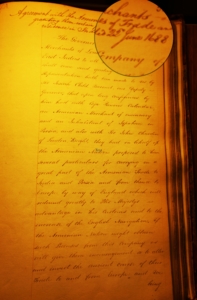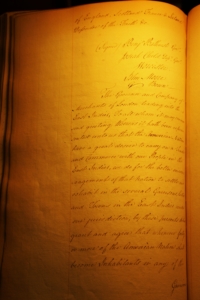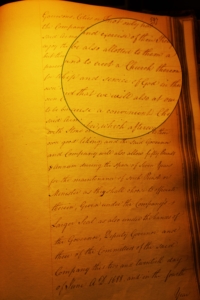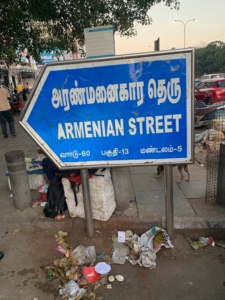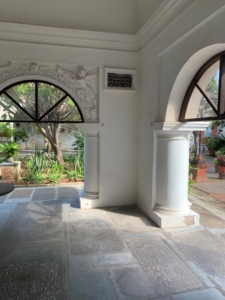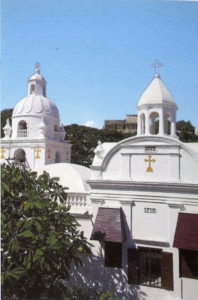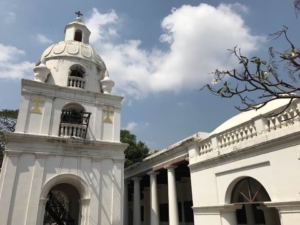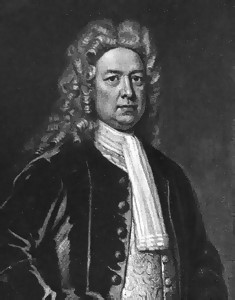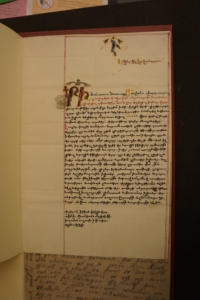A New document on Madras’s First Armenian Church
November 4, 2015
The Armenian church of Saint Mary (Surb Astuatsatsin) in Madras/Chennai which I had the privilege of visiting during my brief fieldwork in India in July of 2003, was built in 1772 on land that previously served as the burial ground for the Armenians. According to Mesrob Seth in his acclaimed book (The Armenians in India from the Earliest Times to the Present, 1897 and 2nd enlarged edition 1939), the property on which the church was erected belonged to Madras’s preeminent Armenian merchant, Agha Shahamir Sultanoum, (i.e., Shahamir Shamirian). In the same work, Seth provides the following brief comments on this church’s history:
“The first Armenian church at Madras was erected as far back as 1712. It was one of the few magnificent edifices in the Esplanade of that city, but the Armenians were obliged to desert it after a time, as the British authorities would not permit so high an edifice to stand in the immediate vicinity of the fort” (580, 1939 edition).
Though Seth as usual does not provide sources for choosing the date 1712 as the earliest possible time for Madras’s first church, it is likely that he was guided by an inscription on one of the church’s walls where the date “1712” is still clearly visible. (see second image below)
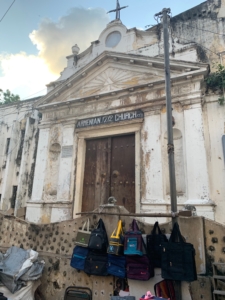 Several pieces of evidence, including a document I recently discovered in the British Library last week and which is the direct occasion for this blog, suggest that 1712 is indeed too late a date for Madras’s first Armenian church. In the first place, no source (in English or Armenian) known to me provides the date when Armenians first built a church for their religious needs. The 1688 “Agreement with the Armenian Nation” signed in London on 22 June and designed to attract Armenian merchants to settle in the Company’s settlements in India (in such places as Bombay, Madras, and, after 1690, Calcutta) included the following crucial clause:
Several pieces of evidence, including a document I recently discovered in the British Library last week and which is the direct occasion for this blog, suggest that 1712 is indeed too late a date for Madras’s first Armenian church. In the first place, no source (in English or Armenian) known to me provides the date when Armenians first built a church for their religious needs. The 1688 “Agreement with the Armenian Nation” signed in London on 22 June and designed to attract Armenian merchants to settle in the Company’s settlements in India (in such places as Bombay, Madras, and, after 1690, Calcutta) included the following crucial clause:
“whenever forty or more of the Armenian Nation shall become Inhabitants in any of the Garrisons, Cities or Towns belonging to the Company in the East Indies, the said Armenians shall not only have and enjoy the free use and exercise of their Religion, but there shall be also allotted to them a parcel of Ground to erect a Church thereon for the worship and service of God in their ow way and that we will also at our own Charge, cause a convenient Church to be built with stone or other Solid Materials to their own good liking …and the said Governor and Company will also allow fifty Pounds per annum during the space of Seven Years for the maintenance of such Priest or Minister as they shall choose to officiate therein.”
Caption: “Agreement with the Armenian Merchants granting them certain privileges of Trade and residence in India dated 22 June 1688”
BL IOR H 634, folios 581-599. Courtesy of the British Library.
The construction of an Armenian church in Madras would have to date after the signing of this agreement. The earliest reference to a church of this type either in the company’s records or in the copious travel literature on the city appears to be Thomas Salmon’s brief description of Madras which dates to the 1699-1700 period where the author notes: “In this Black town stands an Armenian church and severall [sic] little Pagoda’s [sic] or Indian temples.” (See discussion in Henry Davison Love, Vestiges of Old Madras, 1640-1800, vol. 2, 75)
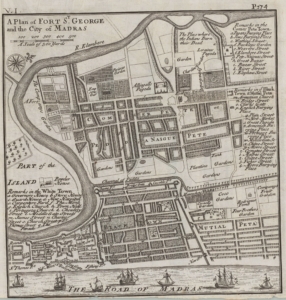
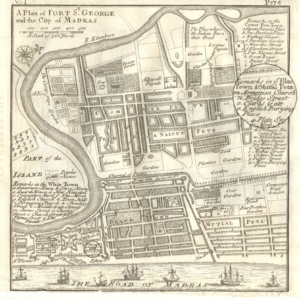 The reference by Salmon might be to an Armenian church in another part of Madras’s “Black Town,” where Armenian, Portuguese, Jewish, and Indian communities of merchants had been settled. The 1712 church with a “high” and “magnificent” edifice that according to Seth the Armenians were “obliged to desert” was probably located in the place (today’s Armenian Street) where in 1772 the present church was built. However, it is almost certain that it was built and consecrated as Saint Mary’s Church [Surb Astuatsatsin] before 1712 and more than likely around 1707. This is purely a hypothesis on my part but one based on some detective-like thinking and circumstantial evidence such as the heretofore never before seen letter I chanced upon in the personal correspondence of the governor of Fort Saint George [i.e., Madras], Sir Thomas Pitt also known as “Diamond Pitt” due to his interest in the diamond mines at Golconda not too far from Madras. This short and beautifully adorned letter from the Primate of New Julfa, Movses Vardapet, was written to Pitt in May of 1709 and thanks the governor for being present at the consecration of Madras’s recently built (նորաշէն) Armenian church of Saint Mary. Since Movses says he heard of the governor’s presence, with his Council, at the church opening from the Armenian head priest in Madras named Ter Avet (whose letters from the period are in the All Savior’s Archive and also in my digital collection), we must conclude that the church must have been consecrated only about two years before Movses’s letter, that is circa 1707 and not 1712 as conventional wisdom would have it. Letters from Madras to Isfahan usually took three months to reach their destination but could take up to a whole year if they were not sent “express.” This means that the consecration date for the church occurred sometime in the two years before Movses Vardapet wrote his “thank you note” to the governor. Below is my provisional transcription and translation of this document which had been misfiled in the British Library Catalogue. It took me a while to track it down in “Dropmore Papers” Additional Manuscripts (ADD) 59481, folio 135.
The reference by Salmon might be to an Armenian church in another part of Madras’s “Black Town,” where Armenian, Portuguese, Jewish, and Indian communities of merchants had been settled. The 1712 church with a “high” and “magnificent” edifice that according to Seth the Armenians were “obliged to desert” was probably located in the place (today’s Armenian Street) where in 1772 the present church was built. However, it is almost certain that it was built and consecrated as Saint Mary’s Church [Surb Astuatsatsin] before 1712 and more than likely around 1707. This is purely a hypothesis on my part but one based on some detective-like thinking and circumstantial evidence such as the heretofore never before seen letter I chanced upon in the personal correspondence of the governor of Fort Saint George [i.e., Madras], Sir Thomas Pitt also known as “Diamond Pitt” due to his interest in the diamond mines at Golconda not too far from Madras. This short and beautifully adorned letter from the Primate of New Julfa, Movses Vardapet, was written to Pitt in May of 1709 and thanks the governor for being present at the consecration of Madras’s recently built (նորաշէն) Armenian church of Saint Mary. Since Movses says he heard of the governor’s presence, with his Council, at the church opening from the Armenian head priest in Madras named Ter Avet (whose letters from the period are in the All Savior’s Archive and also in my digital collection), we must conclude that the church must have been consecrated only about two years before Movses’s letter, that is circa 1707 and not 1712 as conventional wisdom would have it. Letters from Madras to Isfahan usually took three months to reach their destination but could take up to a whole year if they were not sent “express.” This means that the consecration date for the church occurred sometime in the two years before Movses Vardapet wrote his “thank you note” to the governor. Below is my provisional transcription and translation of this document which had been misfiled in the British Library Catalogue. It took me a while to track it down in “Dropmore Papers” Additional Manuscripts (ADD) 59481, folio 135.
Է
Էջէնդ Փիչ [sic?] Կօվօռնադօր։
Քրիստոստի նուաստ ծառայ Մովսէս վարդապէտ որ եւ շնորհօքն աստուծոյ Արք Եպիսկոպոս, մայրաքաղաքիս իսպահանու զետեղեալ քրիստոնէից. Նա եւ ընդ մէզ եղեալ եպիսկոպոսաց. վարդապետաց. եւ քահանայից. որ միշտ հայցեմք ՚ի քրիստոսէ. փրկչէն մերմէ զի մեծապատիւ աղայդ զխոհեմ եւ զխորհրդական. հեզ եւ խորհրդագէտ. հանճարեղ եւ գիտնական. իշխան եւ իշխեզող մադրասու եղեալ … վերոյ գրեալ բարեհամբաւ պարոնաց պարոնիդ. գերամեծար պետիդ հնազանդելոց։
Եւ ընդ փոքրիկ նամակաւս հարցումն առնեմք զմեծութենէ պատուական աղայիդ զոր եւ քրիստոսիւ միշտ լսեմք զբարեբարոյյութեանէ մեծութեանդ այսինքն ՚ի մերայնոց ազանց. եւ մանաւանդ զսէրն որ ունիս առ ՚ի մերայինս զոր եւ մեր որդի Տէր աւէտ քահանայն տեղացդ այլ գրեալէր մեզ թէ մէծացոյն իշխանն, իւր օրհնեալ կօնսէլովն էրէկ մեր նորաշէն եկեղեցոյ օրհնութի[ւն] ետես. եւթէ ուրախութի[ւն] եւս արար, ՚ի սէր անուն սուրբ աստուածածնի շինեալ նորաշէն եկեղեցւոյն մերոյ զոր եւ մեր ընթերցեալ զգրեալսն ՚ի տէր աւետէն մերմէ օրհնեցաք եւ օրհնեմք զքրիստոսասէր իշխանդ, եւ զբարձր թագրաւորութի[ւն] [sic] մեծութեան ձերոյ պահեսցէ զազատագոյն եւ պերճապատիւ իշխանդ յամերամ ժամանօք եւ պարագայծ ամօք [for many years] մինչ ՚ի խորին ծերութիւն. հոգւով եւ մարմնով ուստերօք եւ դստերօք եւ ամենայն ընտանեօք, սիրելեօք եւ բարեկամօք Ամէն։ Այլ եւ գլուխն ամենեցուն քրիստոս աստուած մեր. պահեսցէ անդրդուելի կենօք [firm or strong life] եւ անխրով խաղաղութեամբ զիմաստուն եւ փառաւոր իշխանդ մեր. անգայթակղ եւ անտրտում քաղաքավարութեամբ, եւ զամենայն աւուրս կենացդ անվնաս անցուցանիցես ցնծութեամբ եւ ուրախութեամբ Ամէն
Գրեցաւ ՚ի թիւն փրկչին մերոյ.
ռէճթ Յամսեանն մայիսի ժէ
իսպահան քաղաքի ՚ի ս[ուր]բ ուխտս
Ամենափրկչի։
In the Name of God [Jehova]
To Agent Pitch [sic?] Governor,From the humble servant of Christ, Movses the Archimandrite who is by the grace of God archbishop of the Christians who reside in this metropolis of Isfahan and who along with the bishops, archimandrites, and priests who are at present with us are always beseeching Christ our Savior and praying for the welfare of your honorable lordship who are prudent, gentle, judicious, of rare talent, sovereign, and governor. And with this brief letter we [wish to] ask about the welfare of your honorable lordship whose greatness and kindness towards everyone and especially your love for those of our nation we always hear from [our merchants who are in those parts]. Our son Ter Avet, the priest there, had [recently] written to us that your great lordship with your blessed council had come to our newly built church to witness its consecration. And we were so pleased upon reading what Ter Avet had written of your love for our newly built church named after Mary the Mother of God that that we praised and continue to praise you and pray that God may preserve your High Majesty and Christ-loving prince in your greatness and safeguard your most-free and honorable prince in both spirit and body, with sons and daughters, and your entire family and all your loved ones for many years and at all times until you reach a ripeness of age, Amen. And moreover, may the ruler of all, Christ our God, sustain our wise and glorious prince in his resolute life (անդրդուելի կենօք) with undisturbed tranquility in a state of felicitous government without hindrance, so that you may pass all the days of your life aloof from harm and in happiness and joy, Amen.
Written in the year of our savior
1709 in the month of May 17
In the City of Ispahan at the Convent
of All Saviors.


